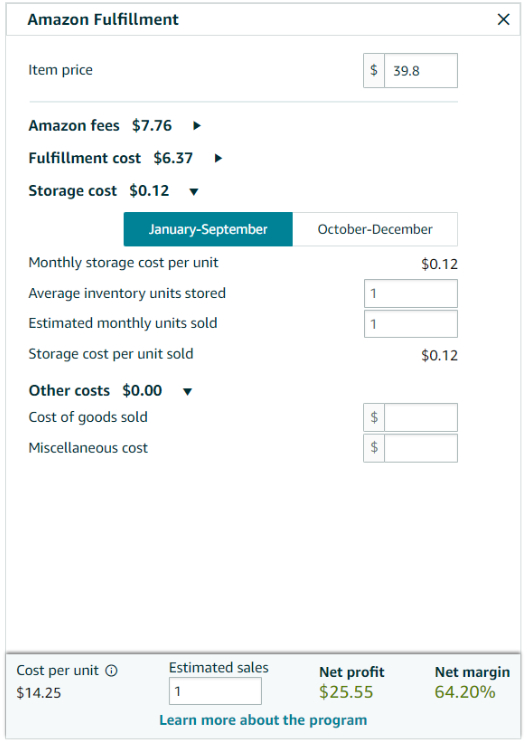Maximizing Profit on Amazon: Utilizing the Amazon FBA Calculator and Analyzing Price History
Selling products on Amazon can be a lucrative venture, but ensuring maximum profitability requires careful planning and strategic decision-making.
In this article, we’ll dive into two game-changing steps: Amazon fees calculation and price history analysis. We’ll explore how to do it effectively to optimize your profits on the Amazon marketplace.
Get ready to skyrocket your profits like never before.
Understanding the FBA Calculator
Picture this: you’ve found a product that seems like a goldmine, but before you hit that “sell” button, it’s essential to understand the fees involved. That’s where the Amazon FBA calculator swoops in to save the day!
The FBA (Fulfillment by Amazon) calculator is a handy tool provided by Amazon that allows sellers to calculate fees and potential profits when using the FBA service. It takes into account various factors such as product dimensions, weight, fulfillment fees, and referral fees.

By inputting these details along with the selling price, sellers can quickly assess their net profit after deducting Amazon’s fees.
How to Use the FBA Calculator by Amazon?
To utilize the FBA calculator, follow these simple steps:
- Identify the product: Determine the specific product you plan to sell on Amazon.
- Gather product information: Collect essential details about your product, including its dimensions and weight. You can find this information on the product packaging or by using a scale and measuring tape.
- Access the FBA Calculator: Go to Amazon Seller Central and find the FBA Calculator tool.
- Enter product details: Input the product’s dimensions, weight, and anticipated selling price.
- Analyze the results: The FBA Calculator will generate a breakdown of the fees involved, including fulfillment and referral fees. It will also provide the estimated net profit.
Analyzing Price History
While the FBA calculator is an invaluable tool for assessing fees and profits, it’s important to consider the market dynamics by analyzing Amazon price history.
Simply relying on Amazon’s tool may not provide a comprehensive understanding of market trends and competition. By studying price history, sellers can make informed decisions regarding pricing strategies, inventory management, and product selection.
Here’s how you can analyze price history effectively:
- Research similar products: Identify products similar to yours and track their pricing trends over time. This can be done using third-party tools or Amazon’s own sales rank history.
- Study seasonal variations: Understand how prices fluctuate during specific seasons or events. For example,
certain products may experience higher demand during holidays, allowing sellers to adjust prices accordingly. - Monitor competitor pricing: Keep an eye on how other sellers are pricing their products. This insight can help you position your own products competitively and adjust your pricing strategy accordingly.
- Consider demand and supply: Analyze how price fluctuations correlate with changes in demand and supply. Adjust your pricing strategy based on these market dynamics to maximize profits.
By combining insights from the FBA calculator with price history analysis, you gain a comprehensive understanding of your product’s profitability potential and the market landscape. This knowledge empowers you to set competitive prices, make data-driven decisions, and maximize your profitability on Amazon.
Why is Amazon Calculator Not Enough?
While the FBA сalculator is a helpful resource, it provides only a snapshot of the financial aspect of your product. It considers factors like dimensions, weight, and selling price to estimate fees and net profit.
However, it falls short of providing comprehensive market insights, competitor analysis, and real-time data that can significantly impact your profitability.
To truly unleash your Amazon selling potential, it’s time to embrace the power of third-party tools. They offer a wide range of advanced features and functionalities that complement and enhance the capabilities of the FBA calculator.
Here’s why you need them in your toolkit:
- In-depth market analysis: Third-party tools provide detailed market analysis, giving you a comprehensive
understanding of your product’s niche. To make data-driven decisions, you can explore product trends, demand patterns, and customer behavior. - Competitor analysis: Gain a competitive edge by accessing valuable competitor insights and comparing their metrics with your listings. Third-party tools help you track and analyze competitor pricing, reviews, and strategies, enabling you to stay one step ahead.
- Sales performance analytics: Go beyond simple fee calculations. Third-party tools offer robust analytics,
allowing you to track your sales performance, measure the impact of pricing changes, and identify areas for improvement. - Inventory management: Efficient inventory management is vital for maximizing profitability. With third-party
tools, you can automate inventory tracking, receive alerts for stock replenishment, and implement dynamic repricing strategies to optimize your sales. - Product research: Discover new opportunities and validate potential niches using product research tools. These tools help you identify high-demand products, evaluate market saturation, and make informed decisions about expanding your product catalog.
Integrating third-party services into your Amazon selling strategy empowers you with valuable insights, time-saving automation, and competitive advantage. These tools complement the FBA calculator’s financial analysis by providing a holistic market view, helping you make informed decisions to drive profitability.
Powerful Resources
Maximizing profit on Amazon requires strategic pricing, accurate cost analysis, and constant adaptation. While utilizing the Amazon FBA calculator and analyzing price history are essential, don’t forget to leverage third-party tools.
These powerful resources provide advanced analytics, market research, and competitor insights to give you a competitive edge. Services like SellerSonar can streamline your selling process and boost your profits.
With the right strategies and resources, you’ll thrive in the dynamic world of Amazon selling. Stay informed, adapt to market trends, and watch your profits soar!

